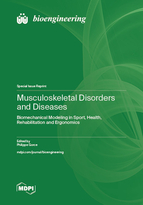Musculoskeletal Disorders and Diseases: Biomechanical Modeling in Sport, Health, Rehabilitation and Ergonomics
A special issue of Bioengineering (ISSN 2306-5354). This special issue belongs to the section "Biomechanics and Sports Medicine".
Deadline for manuscript submissions: closed (31 January 2025) | Viewed by 29349
Special Issue Editor
Interests: work-related musculoskeletal disorders; risk factors; risk assessment; prevalence; occupational ergonomics; dynamic and kinematic motion analysis; posture; biomechanical modeling and simulation; motion analysis; muscle modeling; muscular fatigue; safety; occupational health; sport performance; sport medicine; intelligent wheelchair; neuro- or biorobotics
Special Issues, Collections and Topics in MDPI journals
Special Issue Information
Dear Colleagues,
Protecting people at work and at leisure, and improving their quality of life, is one of the major challenges of our century. From this perspective, understanding the mechanisms that lead to the development of musculoskeletal disorders and diseases is a major multidisciplinary scientific challenge. This Special Issue is dedicated to recent advances in biomechanical modeling research used to explore and understand the musculoskeletal system (macro- and microscopic). Computational techniques, biomechanical calculation tools and numerical tools enable us to quantify and qualify the most important parameters (biomechanical, physiological, biological or environmental) involved in the onset, prevention and reduction of the effects of musculoskeletal disorders and/or the development of musculoskeletal diseases. They can be used as a complement to experimental protocols, clinical studies, process design, ergonomics, etc., to study, evaluate and understand various situations in life, such as repeated movements in the workplace, evaluation of leisure-time physical activities, analysis of sporting movements to assess performance, design of new equipment to compensate for a motor impairment, proposal of new recommendations in a clinical setting, etc. We support all articles promoting the latest research in the fields of sport, health, rehabilitation and ergonomics that contribute to improving people's health and quality of life.
Prof. Dr. Philippe Gorce
Guest Editor
Manuscript Submission Information
Manuscripts should be submitted online at www.mdpi.com by registering and logging in to this website. Once you are registered, click here to go to the submission form. Manuscripts can be submitted until the deadline. All submissions that pass pre-check are peer-reviewed. Accepted papers will be published continuously in the journal (as soon as accepted) and will be listed together on the special issue website. Research articles, review articles as well as short communications are invited. For planned papers, a title and short abstract (about 100 words) can be sent to the Editorial Office for announcement on this website.
Submitted manuscripts should not have been published previously, nor be under consideration for publication elsewhere (except conference proceedings papers). All manuscripts are thoroughly refereed through a single-blind peer-review process. A guide for authors and other relevant information for submission of manuscripts is available on the Instructions for Authors page. Bioengineering is an international peer-reviewed open access monthly journal published by MDPI.
Please visit the Instructions for Authors page before submitting a manuscript. The Article Processing Charge (APC) for publication in this open access journal is 2700 CHF (Swiss Francs). Submitted papers should be well formatted and use good English. Authors may use MDPI's English editing service prior to publication or during author revisions.
Keywords
- musculoskeletal disorders
- musculoskeletal diseases
- injury biomechanics
- muscle biomechanics dynamic and kinematic modeling
- gait and posture
- muscle electromyography
- motion analysis
- postural control and balance
- occupational health
- occupational ergonomics
- sport medicine
- sport performance
- quality of life
Benefits of Publishing in a Special Issue
- Ease of navigation: Grouping papers by topic helps scholars navigate broad scope journals more efficiently.
- Greater discoverability: Special Issues support the reach and impact of scientific research. Articles in Special Issues are more discoverable and cited more frequently.
- Expansion of research network: Special Issues facilitate connections among authors, fostering scientific collaborations.
- External promotion: Articles in Special Issues are often promoted through the journal's social media, increasing their visibility.
- Reprint: MDPI Books provides the opportunity to republish successful Special Issues in book format, both online and in print.
Further information on MDPI's Special Issue policies can be found here.







